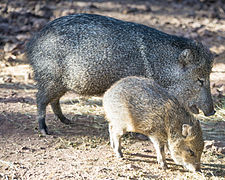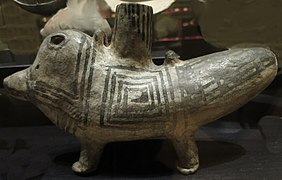Collared peccary
| Collared peccary | |
|---|---|

| |
| Scientific classification | |
| Domain: | Eukaryota |
| Kingdom: | Animalia |
| Phylum: | Chordata |
| Class: | Mammalia |
| Order: | Artiodactyla |
| Family: | Tayassuidae |
| Genus: | Dicotyles Cuvier,1816 |
| Species: | D. tajacu
|
| Binomial name | |
| Dicotyles tajacu | |

| |
| Synonyms | |
|
Pecari tajacu | |
Thecollared peccary(Dicotyles tajacu) is a species ofartiodactyl(even-toed)mammalin the familyTayassuidaefound inNorth,Central,andSouth America.It is the only member of the genusDicotyles.They are commonly referred to asjavelina,saíno,taitetu,orbáquiro,although these terms are also used to describe other species in the family. The species is also known as themusk hog.In Trinidad, it is colloquially known asquenk.[3]
Taxonomy
[edit]Although somewhat related to true Old World pigs, and frequently referred to as a pig, this species and the other peccaries are no longer classified in the pig family,Suidae.Although formerly classified in the genusPecari,studies in 2020 placed them in the genusDicotyles,based on an unequivocal type-species selection; these studies have been accepted by theAmerican Society of Mammalogists.[4][5]Currently, theIUCNstill places them in the genusPecari.[1]
Description
[edit]
The collared peccary stands around 510–610 mm (20–24 in) tall at the shoulder and is about 1.0–1.5 m (3 ft 3 in – 4 ft 11 in) long. It weighs between 16 and 27 kg (35 and 60 lb).[6]Thedental formulais: 2/3,1/1,3/3,3/3.[7]The collared peccary has small tusks that point toward the ground when the animal is upright. It has slender legs with a robust or stocky body. The tail is often hidden in the coarse fur of the peccary.[8]
Range and habitat
[edit]The collared peccary is widespread throughout much of the tropical and subtropicalAmericas,ranging from theSouthwestern United Statesto northernArgentina.They were reintroduced toUruguayin 2017, after 100 years ofextirpationthere.[9]The onlyCaribbeanisland where it is native, however, isTrinidad.Until fairly recently, it was also present on the nearby island ofTobago,but is now exceedingly rare (if not extirpated) due tooverhuntingby humans. An adaptable species, it inhabitsdeserts,xeric shrublands, tropical and subtropical grasslands, savannas, shrublands, flooded grasslands and savannas,tropical and subtropical dry broadleaf forests,and several other habitats; it is also present in habitats shared by humans, merely requiring sufficient cover. Peccaries can be found incitiesand agricultural land throughout their range, where they consume garden plants. Notable populations are known to exist in thesuburbsofPhoenixandTucson, Arizona.[10][11]
Fossil record
[edit]Due to the lack of fossil material or even specimens from archeological sites, it was assumed that javelinas only recently crossed into the US from further south by way of Mexico, being previously excluded from the region by competition with the now-extinctflat-headed peccary(Platygonus compressus) andlong-nosed peccary(Mylohyus nasutus). The first records of the species in its US range are from 18th-century Jesuit missions, and no evidence of remains is known from sites prior to 1700.[12]However, in 2009, a fossil jaw of this species was described fromFlorida,proving that at some point in the late Pleistocene the species had already inhabited part of the Southern US and coexisted with the other two peccary species.[13]The spread of javelinas throughout the Southwest may have been due to the overgrazing of native grasslands by livestock, leading to their replacement bycactiandmesquite,which are more desirable habitat for javelinas.[12]The javelina is also known from fossils from Toca da Barriguda in Bahia, Brazil.[14]
Diet
[edit]Collared peccaries are often classified as herbivores. They normally feed oncactus,mesquitebeans, fruits, berries, seeds, roots,tubers,bulbs,palm nuts,grasses, other green vegetation,fungi,and insects.[3][15]However, they will also eat eggs, snakes, fish, frogs, lizards, dead birds, and rodents if the opportunity presents itself.[16][15]Despite all this supplementary diet, the main dietary components of this species areagavesandprickly pears.[15]In areas inhabited by humans, they also consume cultivated crops andornamental plants,such astulipbulbs.[10][11]
Predators
[edit]The main predators of the collared peccary arecougars(Puma concolor),Mexican wolves(Canis lupus baileyi),coyotes(Canis latrans),jaguars(Panthera onca), andbobcats(Lynx rufus).[17]
Behavior
[edit]Collared peccaries arediurnalcreatures that live in groups of up to 50 individuals, averaging between six and nine animals. They sleep in burrows (often under bushes or larger systems of tree roots), but sometimes can be found in caves, abandoned mines, old desert tunnels, or among logs, felled trees and abandoned timber.[8]However, collared peccaries are not completely diurnal. In central Arizona, they are often more active at night, and less so in the heat of the daytime.
Although they usually ignore humans, they will react if they feel threatened. They defend themselves with their tusks. A collared peccary can release a strong musk or give a sharp bark if it is alarmed.[8]Amazonian peoples (including theShipibos) sometimes raise and tame juvenile collared peccaries, if they are encountered.
Peccary will also rub their scent onto rocks and tree stumps to mark their territory, and rub the scent on each other to help with identification.[16]
The "giant peccary"
[edit]Thegiant peccary(described asPecari maximus) was a purported fourth species ofpeccary,first reported to have been seen inBrazilin 2000 by Dutch naturalistMarc van Roosmalen.In 2003 Germannatural historyfilmmaker Lothar Frenz filmed a group and gathered a skull which later served as thetype(INPA4272). It had been known locally ascaitetú-mundè,which Roosmalenet al.state the locals claimed wasTupíand meant "the collared peccary that is bigger and goes in pairs", as opposed tocaitetú-de-bando,"the collared peccary that goes in herds". It was formallydescribedin 2007,[18]but the scientific evidence for its species status was quickly questioned,[19][20]which also was one of the reasons for its initial evaluation asdata deficientbyIUCNin 2008.[21]A review in 2011 moved the giant peccary intosynonymywith the collared peccary (P. tajacu),[22]which was followed by theIUCNthe same year.[1]
The reported range of the giant peccary encompasses the south-centralAmazonbetween theMadeiraand theTapajós Riversand northernBolivia.[23]It is restricted toterra firmeforest, which is forest that does not flood annually. Unlike other peccaries in its range, the giant peccary was reported to mainly occur in pairs or small family groups.[18]
According to its original description, the giant peccary is larger, longer-legged, and proportionally smaller-headed than the only other member of the genus, the collared peccary.[18]Compared to most individuals of thesympatricpopulations of the collared peccary, the giant peccary also had thinner fur that is grizzled in brown and white, blacker legs, and a relatively faint collar. Five skins of the giant peccary had a total length of 120–137 cm (47–54 in), while local hunters have estimated a weight of 40–50 kg (88–110 lb). Based on amtDNAstudy, the collared and the giant peccaries were estimated to have diverged 1.0–1.2 million years ago, but these results were later questioned due to the smallsample size,lowbootstrapsupport, and the absence ofnDNAandcytogeneticresults.[19][1]
In 2011, a review noted that the measurements provided in the initial description were within those generally recognized for the collared peccary, and the behaviors supposedly unique to the giant peccary are also known from the collared peccary.[22]They also provided new genetic evidence showing that collared peccaries from South America form amonophyleticcladethat includes the giant peccary (without it the clade isparaphyletic). The major genetic split within the collared peccary is between a clade comprising North and Central American specimens, and a clade comprising South American specimens (the presumed contact zone is inColombia,which has both clades). Furthermore, extensiveinfraspecificvariations (both individual and locality-based) are known in themorphologyof the collared peccary.[1]
Gallery
[edit]-
A herd seen by a fixed camera inScottsdale, Arizona
-
Running collared peccary
-
Mother and juvenile
-
A Pueblo drinking vessel
-
A herd of collared peccaries inZagreb Zoo
Explanatory notes
[edit]- ^Excluding the populations of Mexico and the United States of America.
References
[edit]- ^abcdeGongora, J.; Reyna-Hurtado, R.; Beck, H.; Taber, A.; Altrichter, M. & Keuroghlian, A. (2011)."Pecari tajacu".IUCN Red List of Threatened Species.2011:e.T41777A10562361.doi:10.2305/IUCN.UK.2011-2.RLTS.T41777A10562361.en.Retrieved18 February2022.Database entry includes a brief justification of why this species is of least concern.
- ^"Appendices | CITES".cites.org.Retrieved2022-01-14.
- ^ab"Tayassu tajacu (Collared Peccary or Quenk)"(PDF).Sta.uwi.edu.Retrieved9 April2022.
- ^Acosta, Luis E.; Garbino, Guilherme S. T.; Gasparini, Germán M.; Dutra, Rodrigo Parisi (9 September 2020). "Unraveling the nomenclatural puzzle of the collared and white-lipped peccaries (Mammalia, Cetartiodactyla, Tayassuidae)".Zootaxa.4851(1): 60–80.doi:10.11646/zootaxa.4851.1.2.PMID33056737.S2CID222846767.
- ^"Dicotyles tajacu(Linnaeus, 1758) ".ASM Mammal Diversity Database.American Society of Mammalogists.Retrieved2021-10-13.
- ^"Collared Peccary: Javelina ~ Tayaussa ~ Musk Hog".Digital West Media Inc.Retrieved8 January2012.
- ^Reid, Fiona (2006).Peterson Field Guide: Mammals of North America(4th ed.). New York, NY: Houghton Mifflin Company. p. 158.ISBN978-0-395-93596-5.
- ^abcReid, Fiona (2006).Peterson Field Guide: Mammals of North America(4th ed.). New York, NY: Houghton Mifflin Company. p. 488.ISBN978-0-395-93596-5.
- ^"A un año de su liberación, los pecaríes ya se adaptaron y tienen cría".ecos.la(in Spanish). Archived fromthe originalon 2020-04-22.Retrieved2019-04-04.
- ^abFriederici, Peter (August–September 1998)."Winners and Losers".National Wildlife Magazine.36(5).National Wildlife Federation.
- ^abSowls, Lyle K. (1997).Javelinas and Other Peccaries: Their Biology, Management, and Use(2nd ed.).Texas A&M University Press.pp. 61–68.ISBN978-0-89096-717-1.[permanent dead link]
- ^abTaylor, Rick; Synatzske, David R. (2008).The Javelina in Texas(PDF).Texas Parks and Wildlife Department.
- ^Hulbert, Richard C.; Morgan, Gary S.; Kerner, Andreas (January 2009)."Collared peccary (Mammalia, Artiodactyla, Tayassuidae, Pecari) from the late Pleistocene of Florida".Papers on Geology, Vertebrate Paleontology, and Biostratigraphy in Honor of Michael O. Woodburne:543–555 – via ResearchGate.
- ^Alves-Silva, Laís; Cherkinsky, Alexander; Dantas, Mário André Trindade (20 September 2023)."Late Pleistocene mammals from northeastern Brazil caves: Taxonomy, radiocarbon dating, isotopic paleoecology (δ13C), and paleoenvironment reconstruction (δ13C, δ18O)".Quaternary International.668:7–13.doi:10.1016/j.quaint.2023.05.019.Retrieved6 May2024– via Elsevier Science Direct.
- ^abcIngmarsson, Lisa."Pecari tajacu (collared peccary)".Animaldiversity.org.Retrieved9 April2022.
- ^ab"Animal Fact Sheet: Collared Peccary or Javelina".Arizona-Sonora Desert Museum.Retrieved8 December2020.
- ^Ingmarsson, Lisa."Pecari tajacu (collared peccary)".Animaldiversity.org.Retrieved2020-10-28.
- ^abcRoosmalen, M.G.M.; Frenz, L.; Hooft, W.F. van; Iongh, H.H. de; Leirs, H. 2007.A New Species of Living Peccary (Mammalia: Tayassuidae) from the Brazilian Amazon.Bonner zoologische Beiträge 55(2): 105–112.
- ^abGongora, J., Taber, A., Keuroghlian, A., Altrichter, M., Bodmer, R.E., Mayor, P., Moran, C., Damayanti, C.S., González S. (2007).Re-examining the evidence for a ‘new’ peccary species,Pecari maximus,from the Brazilian Amazon.Newsletter of the Pigs, Peccaries, and Hippos Specialist Group of the IUCN/SSC. 7(2): 19–26.
- ^Trials of a Primatologist.Archived2009-10-14 at the Portuguese Web Archive, Smithsonianmag.com. accessed March 15, 2008
- ^Gongora, J. (2008)."Pecari maximus".Retrieved25 November2008.[dead link]
- ^abGongora, J., Biondo, C., Cooper, J.D., Taber, A., Keuroghlian, A., Altrichter, M., Ferreira do Nascimento, F., Chong, A.Y., Miyaki, C.Y., Bodmer, R., Mayor, P. and González, S. (2011).Revisiting the species status ofPecari maximusvan Roosmalen et al., 2007 (Mammalia) from the Brazilian Amazon.Bonn Zoological Bulletin 60(1): 95-101.
- ^Moravec, J., & Böhme, W. (2009).Second Find of the Recently Discovered Amazonian Giant Peccary,Pecari maximus(Mammalia: Tayassuidae) van Roosmalen et al., 2007: First Record from BoliviaArchived2014-11-29 at theWayback Machine.Bonner zoologische Beiträge 56(1-2): 49-54.
External links
[edit]- IUCN Red List least concern species
- Fauna of the Amazon
- Fauna of the Pantanal
- Fauna of the Sierra Madre Occidental
- Fauna of the Sonoran Desert
- Fauna of the Southwestern United States
- Mammals described in 1758
- Mammals of Argentina
- Mammals of Bolivia
- Mammals of Brazil
- Mammals of Colombia
- Mammals of Ecuador
- Mammals of French Guiana
- Mammals of Guyana
- Mammals of Mexico
- Mammals of Paraguay
- Mammals of Peru
- Mammals of Suriname
- Mammals of the Caribbean
- Mammals of the United States
- Mammals of Trinidad and Tobago
- Mammals of Venezuela
- Peccaries
- Taxa named by Carl Linnaeus
- Ungulates of Central America





